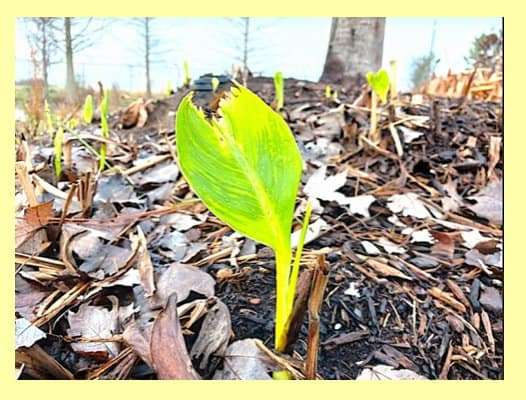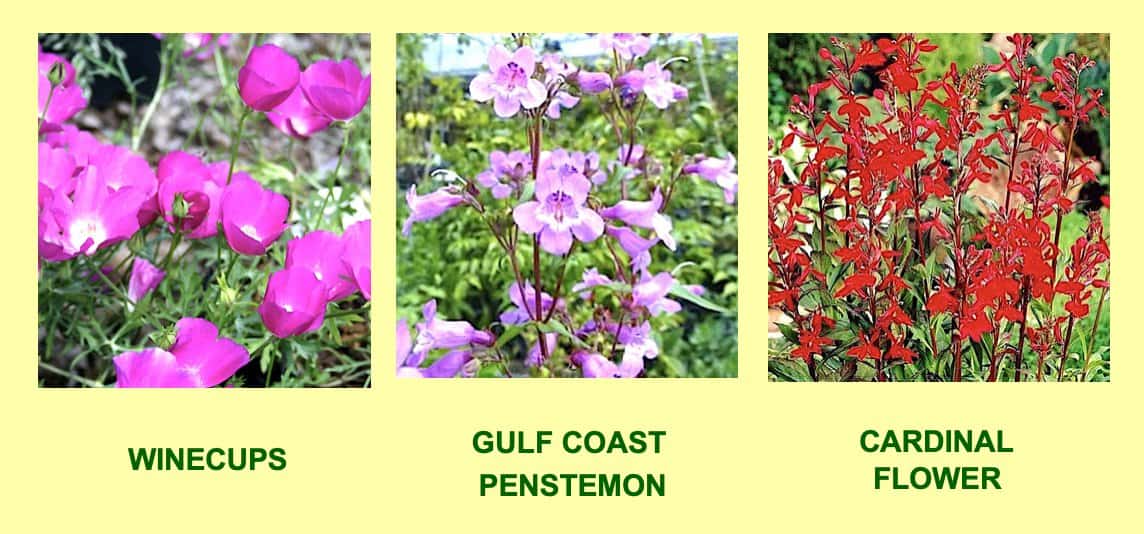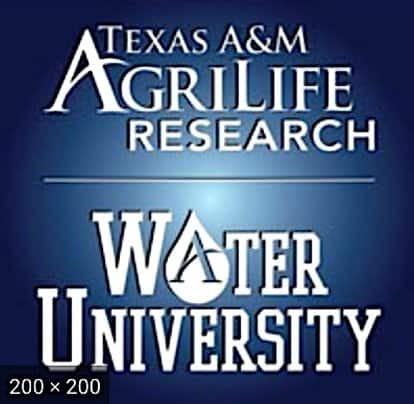


OK, TIME FOR PLANTS TO START RETURNING . . .
A brand new year has started already What will Mother Nature bring?
One thing I know for sure is that
I am very patiently waiting for spring.
— Marilyn Lott, American poet
If ever there were a time when we could all use some Lazarus plant reports, it’s now as we patiently stare at those patches of soil, mulch and brown branches, hoping for tiny sprouts that show sleeping treasures are waking up.
True, late freezes have shaken us up before (eg.,22.5°F recorded on Mar. 3, 1943! ). But predictions for our immediate future are temps no lower than the
low 40s in Feb. So take heart from this great feedback from some of Houston’s knowledgeable gardeners whose TOTALLY UNPROTECTED plants have risen from the “dead,” even after our 13º temps in 2021 and 15º this past December.
- SUSAN KELLY reports her white August Beauty gardenia (left) and brilliant red Midnight Marvel hibiscus both survived the freeze without protection. August Beauty, she writes, “has never bloomed very much” . . until, that is …
“It survived the freeze without protection and has bloomed more this year than it ever has in the past”!


SUZZANNE CHAPMAN, retired Botanical Collections Curator, Mercer Botanic Gardens, and now a Center for Plant Conservation champion, reports her natives doing fine after the freeze include (all file photos, not Suzzanne’s):
Winecups – Callirhoe involucrata
Green headed coneflower – Rudbeckia laciniata Fall Obedient plant – Physostegia virginiana Skullcap – Scutellaria ovata
Baby Blue eyes, seedlings just popping up –Nemophila phacelioides
Creeping Phlox – Phlox subulata
Cardinal Flower – Lobelia cardinalis
Gulf Coast Penstemon – Penstemon tenuis
Missouri violets – Viola missouriensis
Little Gem Magnolias Yaupon – Ilex vomitoria
And, she adds, hopefully all the deciduous trees that are still dormant will be fine: Redbuds, Texas buckeye, Parsley Hawthorne, Mexican Plum.
The best news? None of her perennials even look burned from that arctic blast! Tough guys!
PS. You do know, don’t you, you can google the name of any plant and click on “Images” to see what it looks like? For best accuracy, try to use the botanical name.
GOOD THING TREES DON’T CELEBRATE
ARBOR DAY! The official national Arbor Day (April 28, 2023) was set by (no surprise) a Nebraska arborist who later became U.S. Secretary of Agriculture. Good planting time for his state, not the best for Texas. Our official date is the first Friday in November — the beginning of our best tree planting period— so roots will have plenty of time to get set & growin’ before the heat of summer (their most challenging growing season).
But here we have a much longer prime planting period. Now is optimum which is why we have so many tree sales, especially of fruit and nut trees. See calendar below.
Did you lose someone precious recently? Why not honor them with a tree planted in your yard, or a park, school or other site? Check out your area sites and/or Trees for Houston’s for commemorative planting opportunities and advice: treesforhouston.org › tribute-trees.
WONDERING ABOUT that strange leaf at column top? These are Houston Botanic Garden’s just-leafing-out- cannas, which should be in full green height (with later blooming) when HBG’s “Steve Tobin’s Intertwined: Exploring Nature’s Networks,” begins Sat., Jan. 28, 2023.
However! the exhibit (through Aug. 13) is setting up now, so for regular admissions, visitors will get to see monumental glass, bronze, ceramic and steel structures being set up as well as living & thriving cold-survivors.

NEWS FROM THE WONDERFUL WORLD OF SOIL AND PLANTS # 223
We often talk about the importance of growing more of our own food organically and re-mineralizing the soil. Many medical doctors are unaware of the critical importance of quality nutrition in preventing disease and the link to soil health. However, due to COVID that is changing as this excerpt from a recent medical newsletter indicates.
“Nutrient deficiencies are a major cause of failure of the immune system to prevent a serious infection, and can cause the multiple organ failure and sepsis that occurs in the cytokine storm caused by COVID-19 pneumonia. The problem is not just a diet deficient in essential nutrients such as vitamin Bs, C, D, and minerals such as magnesium, zinc, and selenium — which often happens in our “modern lifestyle” from processed fast food.
In any serious infection such as viral pneumonia, the body’s resources can be quickly depleted fighting the infection, which can cause deficiencies of the very nutrients the body needs to successfully engage the immune system and fight the infection.” Orthomolecular Medicine News Service, Dec 28, 2022
With the recent arctic blast killing many plants, this spring is a great time to start growing more of one’s own fruits, vegetables, and herbs in the empty spaces on re-mineralized soils amended with lots of good compost. Good compost is full of beneficial microbes that help plants absorb all the elements needed.
Many customers are experiencing an increased interest in native plants after the major freezes the last few years. They not only look beautiful, good for butterflies, hummingbirds, and other pollinators, as well as birds and wildlife, they are also heat, drought, flood, and cold tough. A question we often get asked “Is there any restrictions on removing lawns and wildscaping using native plants?”
Often the customer tells us, their HOA prevents them from practicing environmentally friendly landscaping like xeriscaping or wildscaping.
If one hears this from a HOA representative, they are either ignorant of the law or not telling you the truth. As a result of the benefits of environmentally friendly landscaping, the State of Texas passed a law a few years ago preventing HOA’s from keeping folks from practicing conservation, rainwater harvesting, and recycling.
Texas is considered a drought prone state and we are also running out of cheap water from our aquifers. To protect our future, we need to conserve water and use other environmentally friendly options. That is why just a few years ago the State of Texas passed a law that gives homeowners living in an HOA community more control over landscaping their yard with water-saving alternatives.
Below are a few links to the statutes itself and a few articles on the subject one might find interesting:
https://statutes.capitol.texas.gov/Docs/PR/htm/PR.202.htm
https://spectrumam.com/xeriscaping-and-your-texas-hoa/
Senate Bill 198 (2013) – Protection of Drought-Resistant Landscaping and Water-Conserving Natural Turf (also HB 449 – 2013)
“SB 198 modifies Section 202.007 of the Texas Property Code. Section
202.007 restricts HOAs from enforcing a provision of a Dedicatory Instrument that would prohibit or restrict a Homeowner from using drought-resistant landscaping or water-conserving natural turf on his or her property. A HOA may still require a Homeowner to obtain pre-approval of such landscaping or turf from the HOA to ensure, to the extent practicable, maximum aesthetic compatibility of such landscaping or turf with other landscaping in the subdivision, but a HOA’s approval may not be unreasonably denied or withheld.”
It amazes me how many of our local politicians, beaurcrates and HOA boards are so ignorant of these issues. For example, I read the other day that the state of Minnesota is now paying homeowners up to $500 per home to remove their lawn grass and plant Urban Meadows (native grasses, forbs, and wildflowers).
San Antonio has been promoting water conservation landscaping for years with rebates. The Woodlands Water agency offer 50% of the cost of the plants up to $300 per year in rebates to purchase drought tolerant native plants. For additional information see: https://woodlandswater.org/services/rebates
I remember when I was a boy my dad would grow sugarcane in the back yard. The biggest problem he had was his son cutting the stalks down and eating them before he could get to them.
Most children today have never had the wonderful experience of having fresh cut sugarcane to chew on. So this year may be a good time to plant some especially if you have a damp or wet area of your yard.
There are three types of sugarcane:
- Chewing canes – these have a soft fibrous center which makes them good for chewing and a softer outer layer that is easier to peel off. A few of the best chewing canes are ‘White Transparent’, ‘Georgia Red’, ‘Home Green’, ‘LSU290’, Blue Ribbon’, and ‘Yellow Gal’. To find other varieties, search for “heirloom sugarcanes.”
- Syrup canes – these canes have sugar in different chemical forms which can be extracted and used to make sugar syrup. ‘Louisiana Ribbon’, ‘Louisiana Stripped’, and ‘Green German’ are often used for making syrup.
- Crystal canes – these are varieties of cane that have lots of sucrose that can be crystallized for making sugar. These types are grow commercially to make sugar.
Sugar canes can make a very attractive ornamental grass in our gardens and there are several varieties where the leaves have colors and patterns but generally not as good for eating.


If we inspire you to attend any of these, please let them know you heard about it in . . . THE LAZY GARDENER & FRIENDS NEWSLETTER! & please patronize our Newsletter & Calendar sponsors below!
SPONSORSHIP
If you are interested in becoming a sponsor, please contact us at 936-273-1200 or send an e-mail to: lazygardenerandfriends@gmail.com

ABOUT US
BRENDA BEUST SMITH WE KNOW HER BEST AS THE LAZY GARDENER . . . but Brenda Beust Smith is also:
- a national award-winning writer & editor
- a nationally-published writer & photographer
- a national horticultural speaker
- a former Houston Chronicle reporter
When the Chronicle discontinued Brenda’s 45-year-old Lazy Gardener” print column — started in the early ’70s as a fun side-project to reporting, it then ranked as the longestrunning, continuously-published local newspaper column in the Greater Houston area. The name, she says, is not just fun, it’s true. Brenda’s gradual sideways step from reporter into gardening writing led first to an 18-year series of when-to-do-what Lazy Gardener Calendars, then to her Lazy Gardener’s Guide book which morphed into her Lazy Gardener’s Guide on CD, which she now emails free upon request. Brenda became a Harris County Master Gardener and, over the years, served on theboards of many Greater Houston area horticulture organizations. She hosted local radio and TV shows, most notably a 10+-year Lazy Gardener specialty shows on HoustonPBS (Ch. 8) and her call-in “EcoGardening” show on KPFT-FM. For over three decades, Brenda served as Assistant Production Manager of the GARDEN CLUB OF AMERICA’S “BULLETIN” magazine. Although still an active broad-based freelance writer, Brenda’s main focus now is THE LAZY GARDENER & FRIENDS HOUSTON GARDEN NEWSLETTER with John Ferguson and Pablo Hernandez of Nature’s Way Resources. A native of New Orleans and graduate of St. Agnes Academy and the University of Houston, Brenda lives in Humble, TX, and is married to the retired Aldine High School Coach Bill Smith. They have one son, Blake. Regarding this newsletter, Brenda is the lead writer, originator of it and the daily inspiration for it. We so appreciate the way she has made gardening such a fun way to celebrate life together for such a long time.
JOHN FERGUSON John is a native Houstonian and has over 27 years of business experience. He owns Nature’s Way Resources, a composting company that specializes in high quality compost, mulch, and soil mixes. He holds a MS degree in Physics and Geology and is a licensed Soil Scientist in Texas. John has won many awards in horticulture and environmental issues. He represents the composting industry on the Houston-Galveston Area Council for solid waste. His personal garden has been featured in several horticultural books and “Better Homes and Gardens” magazine. His business has been recognized in the Wall Street Journal for the quality and value of their products. He is a member of the Physics Honor Society and many other professional societies. John is is the co-author of the book Organic Management for the Professional. For this newsletter, John contributes articles regularly and is responsible for publishing it.
PABLO HERNANDEZ Pablo Hernandez is the special projects coordinator for Nature’s Way Resources. His realm of responsibilities include: serving as a webmaster, IT support, technical problem solving/troubleshooting, metrics management and quality control. Pablo helps this newsletter happen from a technical support standpoint.

